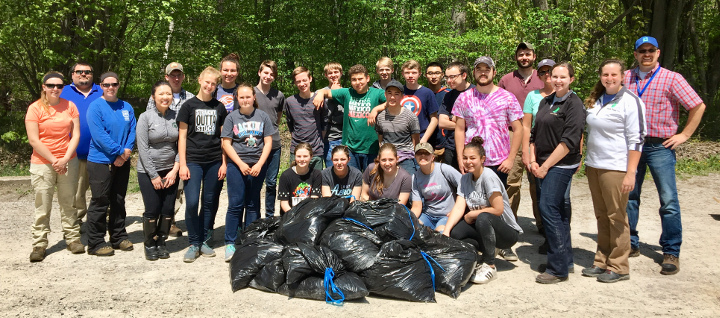By Colby Chilcote
Huron Pines Marketing Director
NORTHEAST MICHIGAN – On a sunny morning in May, Oscoda Area High School students took a break from their regular classroom activities to work alongside Consumers Energy and U.S. Forest Service employees and local volunteers on a habitat restoration project led by Huron Pines Ecologist, Jennifer Muladore and Environmental Education Coordinator, Emily Vogelgesang.
The Annual Garlic Mustard Pull, now in its seventh year, brings together volunteers from across sectors to remove invasive garlic mustard to protect and restore native habitat near Foote Dam on the Au Sable River.
A partner in Consumers Energy
The property belongs to Consumers Energy and is bordered by the Huron National Forest, so once the presence of the invasive plant was identified, it became the perfect opportunity to involve employees and volunteers to turn it from a simple habitat improvement project to an opportunity for stewardship education and community involvement.
Richard Castle, Natural Resources Administrator at Consumers Energy explains, ‘The Au Sable River and its hydro facilities are a special place for many people including Consumers Energy Hydro employees. Besides being the place they work, it’ also a place where many recreate and enjoy on their free time, and they want to ensure the river and the adjacent land is as pristine as it can be for all to enjoy.
“The garlic mustard event is an opportunity for our employees to do exactly that. It’ an opportunity to give back and to help eliminate an invasive species on Consumers’ property and along the Au Sable River.’
Understanding Environmental Challenges in the Field
In addition to improving the habitat for native plants and wildlife, the event provides an opportunity for students to connect with nature.
As Matthew McDougall, Oscoda Area High School science teacher noted, ‘At Oscoda Area Schools we are committed not only to place-based education, but creating the next generation of environmental stewards. What that means for us is providing our students with opportunities to work in the field near our school with community members and professionals, working on managing our natural resources.’
Some students have had the opportunity to participate for multiple years and, ‘Students who have been involved for more than one season have started to make observations which means they now have an idea of what should and should not be there,’ says McDougall. This knowledge will help them to better identify invasive species in the future.
McDougall also credits the event with allowing students to practice stewardship and critical thinking, and giving them a chance to see career opportunities as they work alongside professionals making a living supported by the natural resources in this region.
Castle adds, ‘This event is a building block to grooming our future environmental stewards and allows the volunteers to make an impact in their own backyard and one that has a lasting impact along one of Michigan’ most beautiful and widely used rivers. ‘
An Ongoing Effort to Keep Invasive Species at Bay
Invasive garlic mustard is problematic because it is fast spreading and can alter soil composition and block sunlight, making it difficult for native plants like tree seedlings, trillium and trout lilies to grow. This particular site also includes a healthy population of wild ginger that is threatened by the spreading garlic mustard.
To combat the spread of garlic mustard along the river, volunteers come together once a year to hand-pull hundreds of pounds of the plant with the hopes of one day eradicating it from the area.
‘The real impact is reflected by the amount of garlic mustard that is pulled on a yearly basis and can be seen by the number of bags that are full at the end of the event,’ Castle said. This year, volunteers were able to successfully remove 600 pounds of garlic mustard and according to Huron Pines Environmental Education Coordinator, Emily Vogelgesang, some of the students are noticing the impact of their efforts as they found it harder to find dense patches of the plant like they had in years past.
###
Huron Pines is always looking for new ways to involve local partners, volunteers and students in habitat management and stewardship. In addition to advancing new projects with Consumers Energy and Oscoda Area Schools, we also have plans to partner with Onaway Schools to pilot a new invasive species removal program in their school forest. Plus, the summer is our busiest time for invasive species prevention, detection and removal.
Our summer field crew is out taking inventories and removing invasive plants daily and we’ve launched our mobile boat wash program to educate boaters on the proper method of draining and rinsing their boats to stop the transfer of plant and animal species from one body of water to another. If you’re interested in learning more about our invasive species programs, volunteering with us or have an idea for a new partnership opportunity, you can contact us at invasives@huronpines.org.




